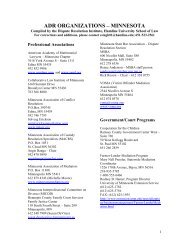LAW AND RELIGION: CASES AND MATERIALS - Hamline Law
LAW AND RELIGION: CASES AND MATERIALS - Hamline Law
LAW AND RELIGION: CASES AND MATERIALS - Hamline Law
Create successful ePaper yourself
Turn your PDF publications into a flip-book with our unique Google optimized e-Paper software.
CARMELLAREV.DOC 4/9/2008 8:28:36 AM<br />
108 JOURNAL OF <strong>LAW</strong> & <strong>RELIGION</strong> [Vol. XXIII<br />
also to the assumption that secularism fosters equality and protects<br />
pluralism. Immediate and strong contrasts and comparisons were drawn<br />
to the U.S. situation. We discussed various religious garb restrictions in<br />
the U.S., which were set forth in the notes, and further discussed the<br />
federal tax code’s electioneering and lobbying restrictions for religious<br />
institutions and other non-profits, which in some ways serve to maintain<br />
a secular political sphere. This brought us right back to the reasons for<br />
separation of governmental and religious functions presented in the<br />
introductory chapter on the Establishment Clause, and got us talking<br />
about whether the secularism of places like France and Turkey is<br />
fundamentally different from the secularism that results from this<br />
separation of function.<br />
The book then delves into Islam and the various types of Islamic<br />
political and legal influence (Islamic states, states in which Islam is the<br />
official religion, states that recognize Islam as a source of law with<br />
special status, etc.). This typology of church-state relations launched the<br />
class into a discussion of whether the U.S. is a “Christian” state, or<br />
whether Christianity functions like an official religion, or receives<br />
special privilege, notwithstanding the Free Exercise and Establishment<br />
Clauses, or whether the Religion Clauses really do function to protect<br />
religious minorities, religious freedom, religious pluralism, and religious<br />
equality. Students offered many diverse views on the impact of the<br />
Religion Clauses.<br />
The final chapter (ch. 10) is entitled “The Old and New <strong>Law</strong> of<br />
Religion.” It begins with the famous “Amish case,” Wisconsin v.<br />
Yoder, 17 and then presents a nice excerpt from Diana Eck’s work on<br />
religious diversity in America regarding the growing Muslim, Buddhist,<br />
Hindu and Sikh populations. My class came back around to the question<br />
of religious exemptions, autonomy (and survival) of religious groups,<br />
and the challenges that lay ahead as we become increasingly pluralistic.<br />
We returned to the fundamental question of the course: how do varying<br />
interpretations of the Religion Clauses promote or hinder efforts to<br />
foster pluralism, to ensure freedom without anarchy, to enable<br />
particularistic identities within civil society without undermining what is<br />
held in common?<br />
My enthusiasm for <strong>Law</strong> and Religion is boundless, for all the<br />
reasons I’ve expressed. Professor Griffin has written a most engaging<br />
case book that gets students (and their professors) thinking, talking, and<br />
learning.<br />
17. 406 U.S. 205 (1972).
















